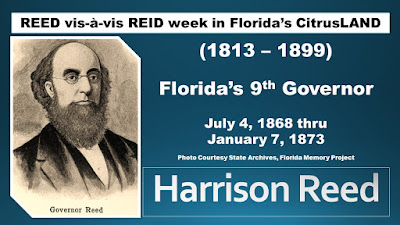Sir Edward James REED of England was an interesting player in
the story of Florida’s developing 19th century Citrus Belt as well. Parts
One & Two of this week long series featured two Florida Governors, pre-Statehood
REID and one post-Statehood REED. They were not related, but in their own
unique way left their marks on central Florida history. This Part Three
introduces a REED from across the pond.
Sir Edward James and wife Lady Rosetta REED, of Hextable, Kent
County, England, acquired 65,000 acres of central Florida wilderness in 1883,
transferring the land to a holding company, Florida Land & Mortgage Company
Limited. REED was Chairman.
Born at Sheerness, England in 1830, Sir REED became Chief
Constructor for the British Navy, holding that position from 1863 until 1870.
REED then wemt out on his own, and as a naval constructor and engineer, did
business with Russia, Australia and Turkey.
Sir Edward James REED’S financial interests in the 1880s
expanded to include railroads and land development in the USA, Florida in
particular. He organized Florida Central & Western Railroad, planning to
lay down 234 miles of railroad from Jacksonville to Chattahoochee.
REED also acquired the 65,000 acres in CitrusLANDFL, as well
as other Florida land, and his company provided financing to their buyers. Orlando
Municipal Airport began service in 1928. Operating as Orlando Executive Airport
today, its runways cross land that, in 1883, belonged to John DEUTSCHMAN, a German
immigrant who purchased his land from Sir Edward James REED of Hextable,
England.
Yet another purchaser of REED properties was George W.
Lockwood of Connecticut. An early East Orange County settler, Lockwood and his
son founded Lockwood Post Office, an early Econlockhatchee River crossing. Much
of REED’S land surrounded BITHLO of today.
REED outlived his Florida business ventures, living until
1906, and being laid to rest in his birth country of England.
We’ve now presented three histories of 19th century
individuals who played key roles in a developing central Florida, each being
named REID or REED. But tomorrow we tell the story of Floridian who, like the
comedian Rodney Dangerfield, couldn’t get any respect. He first rescued one of
Orange County’s most important cities, only to have that town’s plat spell out
his name as both REED and REID. We’ll sort out that mess in tomorrow’s Part Four
of REED vis-à-vis REID Week.


